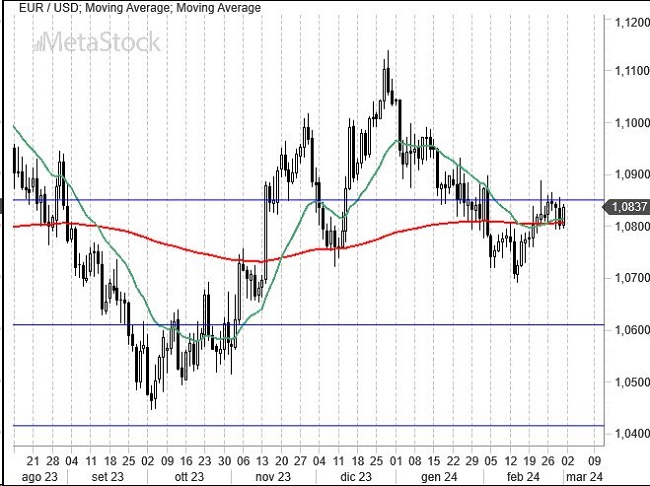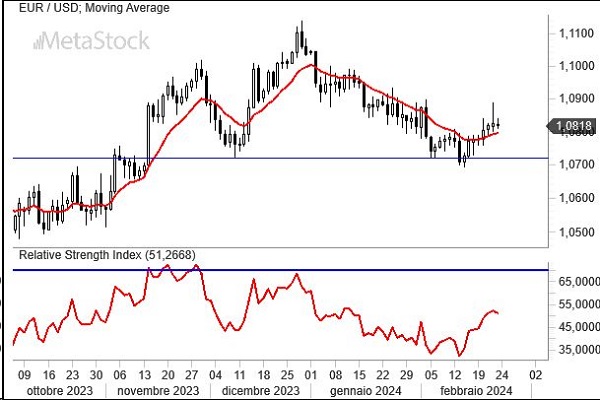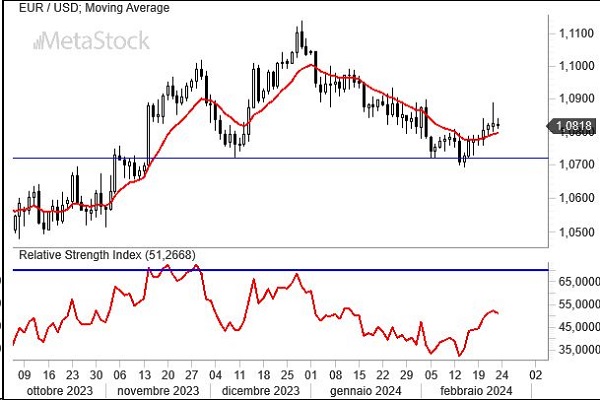- American markets reaching historical highs in the stock market, also boosted by a very lively Bitcoin. The change in central bankers’ stance on rates, with cuts expected later, seems to be already priced in.
- A mild optimism is also felt in Europe where the spreads between peripheral and core bonds are significantly narrowing, confirming that traders see fewer risks (and lower rates) on the horizon. Inflation and macroeconomic data confirm this.
- EurUsd continues to stay above the 1.08 support levels, affirming the significance of these technical levels and the market’s belief that the US-Europe interest rate differential will not widen.
Fed Rate Cuts, Robust Growth, and Political Dynamics
Once upon a time, there were anticipated rate cuts promised by the Fed. With each passing week, expectations for a reduction in the cost of money have shrunk, and as of today, the market anticipates a cut of 75 basis points by the end of 2024, down from 150 at the start of the year. Growth remains robust even though the recent ISM manufacturing data has highlighted some emerging issues. The decline in consumer confidence could be a significant symptom. The Atlanta Fed cur rently forecasts growth of over 3% for the first quarter, while the New York Fed’s model is slightly lower. Optimism pervades trading floors as central bankers, with a rhetoric that has shifted from a few weeks ago, seem keen to guard against the risk of inflation rebounding. Meanwhile, it’s practically official that Trump vs. Biden will be the matchup in the November presidential election, barring any legal developments that could halt the tycoon’s run. This matchup evidently pleases financial markets, buoyed also by the powerful rally in Bitcoin following the listing of new ETFs. In Europe, it’s worth noting the calm atmosphere in the world of spreads between Mediterranean countries and those considered more fiscally disciplined. The interest rate differential between Italian BTPs and German Bunds has fallen below 150 basis points, the lowest in the last two years. There’s confidence in the single currency, evidenced not only by the dollar’s inability to break lower support levels but also by the strong recovery of EurChf. Further cooling inflation and disappointing macroeconomic data from Germany strengthen the case for ECB action before the Fed by summer.
Technical Analysis: The Euro’s Resilience
Analyzing the short-term chart, the bear trap set in early February seems to have been confirmed by the comparison between short and long-term moving averages. Returning above 1.08 is significant not just because it has surpassed the 200-day average, but also because it may have ended the Euro’s decline that began in December. The battle is still ongoing, and the buffer zone between 1.07 and 1.08 remains the most delicate for the single currency, likely holding until the next central bank meetings. A definitive move away from the 200-day moving average would confirm a return to the 1.10/1.12 zone in the coming months, when the dollar’s seasonal favorability diminishes.

The Relative Momentum Index (RMI) appears to confirm the Euro’s recovery capacity after reaching a certain oversold level. The RMI, as has happened on other occasions, has managed to rally, coinciding with a recovery in the EurUsd exchange rate. It’s reasonable, therefore, to expect the Euro’s rally to continue until the oscillator at least reaches an overbought level.



Leave a Reply
You must be logged in to post a comment.